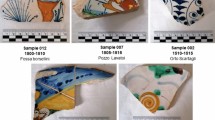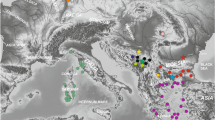Abstract
Lead isotopes are a well-established tool to trace the geographic origin of samples and artefacts in archaeology and geochemistry. In archaeology, lead isotopes are often applied to gain information on the provenance of the used ores especially in lead and silver artefacts. The assignment of a specific and unambiguous provenance in most cases is not possible or at least hindered due to several limitations such as ore deposits overlapping in their lead isotopic composition, a large spread within one ore deposit or a missing overlap with known mining sites. Such difficult cases can only be solved by using information from sources being independent of the isotope data. This information can be of chemical nature such as concentrations of key elements or they can be of archaeological nature such as cultural or trade route information. Within this study, we combined lead isotope data of ores and artefacts with silver mass fractions in the ore deposits, Au/Ag-ratios in ores and artefacts and finally archaeological information on the cultural context in the Mediterranean and Anatolian Region. This approach enabled us to significantly reduce the potential number of mining regions. Finally, the potential sources could be narrowed down to the three remaining locations the Central Taurus, Arap Dağ and the Eastern Troad. Beneath these three locations, the Central Taurus shows the highest probability for the geographic origin of the galena which has been used to create the Trojan silver artefacts.




Similar content being viewed by others
References
Archi A (1988) Testi administrativi: Registrazioni di metalli e tessuti (Archivo L.2769). Archivi reali di Ebla, Testi 7, Roma; identical with: Archi A (1996). Bibliotheca Orientalis 53:474–479
Bachhuber G (2009) The treasure deposits of Troy: rethinking crisis and agency on the Early Bronze citadel. Anatol Stud 59:1–18
Bogdanov K, Todorova D, Kuncheva J and Stoyanova S (2013) Western Anatolian precious metal deposits. https://www.academia.edu/29595800/Western_Anatolian_Precious_Metal_Deposits (last accessed: 2018-11-26)
Born H (1997) Trojan silver vessels: a research project on the material and manufacture and the options for conservation. Acta Praehist Archaeol 29:110–121
Born H, Völling E (2006) Beutekunst in Mesopotamien: Ein Silbergefäß aus dem «Schatz des Priamos» aus Troja bietet noch heute Überraschungen. Antike Welt 1-2:61–67
Born H, Rhede D and Romer R. L. (2014) Trojanisches Silber in Berlin und St. Petersburg. Archäometrische Untersuchungen zwischen 1996 und 2013. M Wemhoff, D Hertel, A Hänsel (ed) Heinrich Schliemanns Sammlung Trojanischer Altertümer – Neuvorlage Bd. 2, Berliner Beiträge zur Vor- und Frühgeschichte NF, 18, pp 41–108
Brill RH, Wampler JM (1965) Isotope studies of ancient lead. Am J Archaeol 69(2):165–166
Çalış-Sazcı D (2006) Die Troianer und das Meer – Keramik und Handelsbeziehung der sog. “Maritimen Troia-Kultur”. In: Korfmann MO (ed) Archäologie eines Siedlungshügels und seiner Landschaft. Philip von Zabern Verlag, Darmstadt, pp 201–208
Cui J, Wu X (2011) An experimental investigation on lead isotopic fractionation during metallurgical processes. Archaeometry 53(1):205–214. https://doi.org/10.1111/j.1475-4754.2010.00548.x
D-Maps (2017) Free outline and blank maps. http://d-maps.com. Last accessed 16.05.2017
Earl B, Özbal H (1996) Early bronze age tin processing at Kestel/Göltepe, Anatolia. Archaeometry 38:289–303
Efe T (2002) The interaction between cultural/political entities and metalworking in Western Anatolia during the Chalcolithic and Early Bronze Age. In: Yalcin Ü (ed) Anatolian Metal II, Der Anschnitt, Beiheft 15. Dt. Bergbaumuseum, Bochum, pp 49–65
Gale NH, Stos-Gale ZA (1981) Cycladic lead and silver metallurgy. Annual of the British School at Athens 76:169–224
Gale NH and Stos-Gale ZA (1996) Lead isotope methodology: the possible fractionation of lead isotope compositions during metallurgical processes. In: Archaeometry 94, Ankara, 1994. Tübitak, p 287–299
Genter W, Gropengiesser H, Wagner GA (1979/1980) Blei und Silber im ägäischen Raum. In: von Ditfurth H (ed) Mannheimer Forum 79/80. Boehringer Mannheim GmbH, Mannheim, p 143 ff
Georgakopoulou M, Bassiakos Y, Philaniotou O (2011) Seriphos surfaces: a study of copper slag heaps and copper sources in the context of Early Bronze Age Aegean metal production. Archaeometry 53(1):123–145. https://doi.org/10.1111/j.1475-4754.2010.00529.x
Günbattı C (1998) Kültepe’den Akadalı Sargon’a ait bir tablet. In: III. Uluslararası Hititoloji Kongresi Bildirileri, Çorum 16–22 Eylül 1996, Ankara, pp 261–279
Harding AF (2000) European societies in the Bronze Age. Cambridge University Press, Cambridge
Hauptmann A (2008) Erzlagerstätten im östlichen Mittelmeerraum. In: Yalcin Ü (ed) Anatolian Metal IV, Der Anschnitt, Beiheft 21. Dt. Bergbaumuseum, Bochum, pp 55–66
Holleman AF, Wiberg E (1995) Lehrbuch der Anorganischen Chemie. Walter de Gruyter Verlag, Berlin
Ivanova M (2008) Befestigte Siedlungen auf dem Balkan. In: der Ägäis und in Westanatolien, ca. 5000–2000 v. Chr. Tübinger Schriften zur ur- und frühgeschichtlichen Archäologie, Band. Waxmann Verlag, Münster, p 8
Koch S, Born H (2001) Trojan silver vessels: the analysis of the manufacturing techniques and the conservation of a vessel with “Schnuröse” [cord lug] [SCH 5861]. Acta Praehist Archaeol 33:252–266
Korfmann M (2001) Der “Schatz A” und seine Fundsituation. In: Meyer JW, Novák M, Pruß A (eds) Beiträge zur Vorderasiatischen Archäologie, Festschrift für W. Orthmann. Johann Wolfgang Goethe-Universität, Frankfurt a. M., pp 212–235
Mabuchi H, Hirao Y, Nishida M (1985) Lead isotope approach to the understanding of early Japanese bronze culture. Archaeometry 27(2):131–159
Maran J (1998) Kulturwandel auf dem griechischen Festland und den Kykladen im späten 3. Jahrtausend v. Chr.. Universitätsforschungen zur Prähistorischen Archäologie Vol. 53, Dr. Rudolf Habelt Verlag, Bonn, pp 259–271
Mellink MJ (1986) The Early Bronze Age in West Anatolia: Aegean and Asiatic correlations. In: Cadogan G (ed) The end of the Early Bronze Age in the Aegean. Brill Academic Publisher, Leiden, pp 139–152
Müller-Karpe A (1994) Altanatolisches Metallhandwerk. Offa-Bücher 75, Wachholtz Verlag, Neumünster, pp 43–49
OXALID (2014) Oxford archaeological lead isotope database from the Isotrace Laboratory. http://oxalid.arch.ox.ac.uk. Last accessed 18/10/2018
Pernicka E, Wagner GA (1985) Thasos als Rohstoffquelle für Bunt- und Edelmetalle im Altertum. In: Wagner GA, Weisgerber G (eds) Antike Edel- und Buntmetallgewinnung auf Thasos, Der Anschnitt, Beiheft 6. Dt. Bergbaumuseum, Bochum, pp 224–231
Pernicka E, Lutz C, Bachmann H-G, Wagner GA, Elitzsch C, Klein E (1985) Alte Blei-Silber-Verhüttung auf Sifnos. In: Wagner GA, Weisgerber G (eds) Silber, Blei und Gold auf Sifnos, Der Anschnitt, Beiheft 3. Dt. Bergbaumuseum, Bochum, pp 185–199
Pettinato G (1977) The archives of Ebla. Monographic Journals of the Near East, Syro-Mesopotamian Studies 1(1):3–30
Pomponio F, Xella P (1997) Les dieux d’Ebla: Étude analytique des divinités éblaïtes à l’époque des archives royales du IIIe millénaire. Alter Orient und Altes Testament 245. Ugarit Verlag, Münster ISBN 3-927120-46-4
Reiter K (1997) Die Metalle im Alten Orient unter besonderer Berücksichtigung altbabylonischer Quellen. Altes Testament und Alter Orient 249. Ugarit Verlag, Münster ISBN 3-927120-49-9
Riederer J (2002) Die Berliner Datenbank von Metallanalysen kulturgeschichtlicher Objekte, IV. Objekte der mitteleuropäischen Bronzezeit sowie etruskische, sardische, griechische, ägyptische und vorderasiatische Objekte. Berliner Beiträge zur Archäometrie 19:72–225
Romer RL, Born H (2009) The origin of the Trojan silver: lead isotope constraints. Acta Praehist Archaeol 41:23–27
Şahoğlu A (2005) Izmir region excavations and research project during the Bronze Age. Oxf J Archaeol 24:339–361
Şahoğlu A (2009) Izmir region excavations and research project (IRERP) B I Class Stud 52:263–264. https://doi.org/10.1111/j.2041-5370.2009.tb00763.x
Saszı G, Korfmann M (2000) Metallfunde des 3. Jahrtausends v. u. Z. aus Troja – Eine Studie in Verbindung mit den Ergebnissen der neuen Ausgrabungen. In: Yalcin Ü (ed) Anatolian Metal I, Der Anschnitt, Beiheft 13. Dt. Bergbaumuseum, Bochum, pp 93–100
Scaife B (1997) Lead isotope ratios for Mediterranean ores. Available as open document format from: http://www.brettscaife.net/lead/data/index.html. Last accessed 12.05.2017
Schliemann H (1874) Atlas der Trojanischen Alterthümer, Leipzig
Schmidt H (1902) Heinrich Schliemann’s Sammlung Trojanischer Altertümer. Verlag von Georg Reimer, Berlin
Stos-Gale ZA, Gale NH, Annetts N (1996) Lead isotope data from the Isotrace Laboratory, Oxford: Archaeometry Data Base 3, ores from the Aegean. Part 1. Archaeometry 38(2):381–390. https://doi.org/10.1111/j.1475-4754.1996.tb00784.x
Stos-Gale ZA, Gale NH, Annets N, Todorov T, Lilov P, Raduncheva A, Panayotov I (1998) Lead isotope data from the Isotrace Laboratory, Oxford: Archaeometry database 5, ores from Bulgaria. Archaeometry 40(1):217–226
Vogl J, Paz B, Koenig M, Pritzkow W (2013) A modified lead–matrix separation procedure shown for lead isotope analysis in Trojan silver artefacts as an example. Anal Bioanal Chem 405(9):2995–3000. https://doi.org/10.1007/s00216-012-6323-x
Vogl J, Rosner M, Curbera J, Peltz U, Peplinski B (2018) Lead isotope analysis in magic artefacts from the Berlin museums. Archaeol Anthropol Sci 10:1111–1127. https://doi.org/10.1007/s12520-016-0445-6
Völling E (2014) Die Silbergefäße aus Schatzfund A in der Berliner Sammlung. Kultgerät im anatolisch-mesopotamischen Kontext. In: M Wemhoff, D Hertel, A Hänsel (ed) Heinrich Schliemanns Sammlung Trojanischer Altertümer – Neuvorlage Bd. 2, Berliner Beiträge zur Vor- und Frühgeschichte NF, vol 18, pp 11–35
Völling E, Reifarth N and Vogl J (2012) The intercultural context of Treasure A in Troy—jewelry and textiles. In: M-L Nosch, R Laffineur (Hg) Jewelry, adornment, and textiles in the Aegean Bronze Age, Proceedings 13th International Aegean Conference, pp 531–538
Wagner GA and Öztunalı Ö (2000) Prehistoric Copper Sources in Turkey. Der Anschnitt, Beiheft 13, Anatolian Metal I: 35
Wagner GA, Gentner W, Gropengiesser H and Gale NH (1980) Early Bronze Age lead-silver mining and metallurgy in the Aegean: the ancient workings on Siphnos. British Museum Occasional Paper, pp 2063–85
Wagner GA, Pernicka E, Seeliger TC, Oztunali O, Baranyi I, Begemann F and Schmitt-Strecker S (1983/1984) Geologische Untersuchungen zur frühen Metallurgie in NW-Anatolien. Bulletin of the Mineral and Exploration Institute of Turkey 101–10245-81
Wagner GA, Pernicka E and Seeliger TC (1986) Geochemische und isotopische Charakteristika frueher Rohstoffquellen fuer Kupfer, Blei, Silber und Gold in der Türkei. Jahrbuch des Roemisch-Germanischen Zentralmuseums Mainz. vol 33, pp 723–752
Yakar J (2008) East Anatolian metallurgy in the Fourth and Third Millenium BC: some remarks. In: Yalcin Ü (ed) Anatolian Metal IV, Der Anschnitt, Beiheft 21. Dt. Bergbaumuseum, Bochum, pp 15–25
Yener KA, Sayre EV, Joel EC, Özbal H, Barnes IL, Brill RH (1991) Stable lead isotope studies of central Taurus ore sources and related artifacts from eastern Mediterranean chalcolithic and bronze age sites. J Archaeol Sci 18(5):541–577
Acknowledgements
The authors expressly thank the “Museum für Vor- und Frühgeschichte, Staatliche Museen zu Berlin”, Berlin, especially Hermann Born and Matthias Wemhoff, for providing the samples and photographs.
Author information
Authors and Affiliations
Corresponding author
Additional information
Publisher’s Note
Springer Nature remains neutral with regard to jurisdictional claims in published maps and institutional affiliations.
Rights and permissions
About this article
Cite this article
Vogl, J., Paz, B. & Völling, E. On the ore provenance of the Trojan silver artefacts. Archaeol Anthropol Sci 11, 3267–3277 (2019). https://doi.org/10.1007/s12520-018-0756-x
Received:
Accepted:
Published:
Issue Date:
DOI: https://doi.org/10.1007/s12520-018-0756-x




